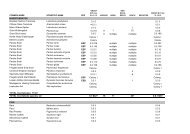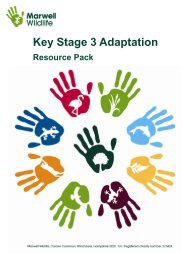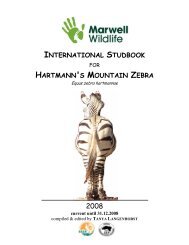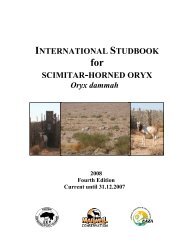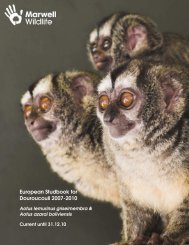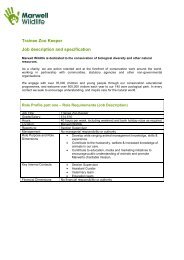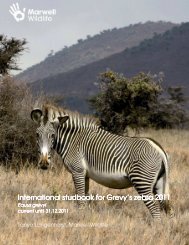International International studbook for Grevy's zebra ... - Marwell Zoo
International International studbook for Grevy's zebra ... - Marwell Zoo
International International studbook for Grevy's zebra ... - Marwell Zoo
You also want an ePaper? Increase the reach of your titles
YUMPU automatically turns print PDFs into web optimized ePapers that Google loves.
Grevy’s Grevy’s <strong>zebra</strong> <strong>zebra</strong> cconservation<br />
c onservation activities<br />
Groups and organisations mentioned in this report are:<br />
AWF = African Wildlife Foundation www.awf.org<br />
GZT = Grevy’s <strong>zebra</strong> Trust www.grevys<strong>zebra</strong>trust.org<br />
GZTC = Grevy’s <strong>zebra</strong> Technical Committee<br />
KWS = Kenya Wildlife Service www.kws.org<br />
Lewa or LWC = Lewa Wildlife Conservancy www.lewa.org<br />
<strong>Marwell</strong> = <strong>Marwell</strong> Wildlife www.marwell.org.uk/conservation<br />
NRT = Northern Rangelands Trust www.nrt-kenya.org<br />
Princeton = University of Princeton/Denver <strong>Zoo</strong> www.princeton.edu/~equids/people.html<br />
STE = Save the Elephants www.savetheelephants.org<br />
For more detailed in<strong>for</strong>mation on all these, please see previous <strong>studbook</strong>s.<br />
National Developments:<br />
National survey<br />
As part of the National Conservation & Management Strategy <strong>for</strong> Grevy’s <strong>zebra</strong> (Kenya Wildlife Service 2008), the<br />
range of Grevy’s <strong>zebra</strong> in Kenya has been divided into five contiguous management zones (Fig. 1). Four of these<br />
zones were covered during the National Survey in 2008 (Low et al., 2009). The very remote North zone, including<br />
Marsabit, Chalbi Desert and the eastern shore of Lake Turkana, however, was excluded due to its large size and<br />
perceived low density of species, making it prohibitively expensive to survey from the air. Hence, the conservation<br />
status of wildlife in this zone had not been established <strong>for</strong> several years. Two previous surveys, one a comprehensive<br />
photograph survey in 2000 (Nelson & Williams, 2003), the other a preliminary investigation into the persistence of<br />
Grevy’s <strong>zebra</strong> and the merits of further conservation work in 2005 (Woodfine et al. 2009), indicated a decline in<br />
populations of large mammals <strong>for</strong> this region.<br />
The Grevy’s <strong>zebra</strong> Technical Committee undertook a survey of the North Zone from 1st-23rd February 2010 using three<br />
vehicles and a team of 10 people to fill the gap in knowledge <strong>for</strong> this zone. While previous surveys had focused on<br />
Grevy’s <strong>zebra</strong> distribution and numbers, this latest one also included a range of other large mammals and looked into<br />
the specific threats faced by wildlife in this region. A combination of transect counts, sociological questionnaires and<br />
interviews with key local people was used.<br />
Fig. 1: Map of five management zones<br />
So far, only preliminary results on survey objectives, methods and initial results on the distribution of Grevy’s <strong>zebra</strong>,<br />
other wildlife and livestock has been produced (Low et al., 2010) and they confirm the conclusion by the 2005 survey<br />
that Grevy’s <strong>zebra</strong> persist around Sibiloi National Park and in the eastern Chalbi Desert and that these populations<br />
appear vulnerable to localised extinction.<br />
Key observations as to why this decline has occurred were:<br />
• livestock outnumbered wildlife by many orders of magnitude and is likely to displace wildlife spatially<br />
• access to water often restricted to livestock watering locations, some of which have recently been developed to<br />
prevent animals from accessing the water directly. This causes major issues <strong>for</strong> Grevy’s <strong>zebra</strong> and other wildlife that<br />
depend on access to water on a daily basis.<br />
• poaching also appears to be a major issue, with a proliferation of guns and an erosion of cultural taboos leading to<br />
more widespread hunting<br />
Based on these findings, it is now believed that the populations in El Barta and Laisamis are now the northernmost<br />
fringe of viable Grevy’s <strong>zebra</strong> populations in Kenya, and a critical buffer to the core Samburu/Laikipia population (GZT<br />
News, 2010). A full report will be published in 2011 after analysis of the questionnaire survey has been completed.<br />
AII<br />
Interviews during 2010 survey © <strong>Marwell</strong>





